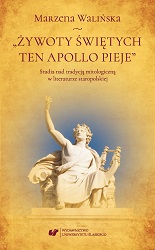„Żywoty świętych ten Apollo pieje”. Studia nad tradycją mitologiczną w literaturze staropolskiej
„Żywoty świętych ten Apollo pieje”. Studies on mythological tradition in Old Polish literature
Author(s): Marzena Walińska
Subject(s): Language and Literature Studies, Studies of Literature, Polish Literature
Published by: Wydawnictwo Uniwersytetu Śląskiego
Keywords: mythology; Old Polish literature; ancient literature; preaching;ancient traditions;
Summary/Abstract: The present book is a collection of selected aspects of the reception and functioning of mythological tradition in the literature of Renaissance and Baroque. In the first part, there are texts that specify the attitude towards mythology adopted by two most important Polish writers of the Renaissance period: Mikołaj Rej and Jan Kochanowski. The analysis of the nature of the mythological references presented in the article entitled Rej i mitologia [Rej and mythology] confirms the hypotheses formulated in the latest research into Rej’s writings on its medieval roots. It is evidenced by the following: the derogatory assessment of mythological tradition; the interpretation and adaptation of antique motifs in a spirit of allegoresis, euhemerism, and astrology; the sources of mythological knowledge and the place of mythologisms in the structure of a literary work. Rej did not consider mythology as an indispensable constituent of poetic language, which is demonstrated in the works that are completely devoid of it. The article entitled ”Owa prosto będziecie ze mnie mieć Chirona”. Kod mitologiczny „Fraszek” Jana Kochanowskiego [ ”Owa prosto będziecie ze mnie mieć Chirona”. The mythological code of ‘Epigrams’ by Jan Kochanowski”] advances a thesis that Kochanowski took advantage of mythological tradition intentionally and deliberately. Even in the translations of antique literature, mythologisms were not taken over automatically, but rather were subjected to the process of adaptation and selection. The juxtaposition of Epigrams with foricoena confirms the assumption that the manner of employing mythological tradition is a part of poetic strategy of Kochanowski. Moreover, it seems that, to some extent, the conclusions reached on the basis of the analysis of mythologisms in Epigrams may be related to the whole Polish-language writings of the poet. The second part is devoted to the studies on baroque religious literature represented by three separate research fields. The study Apollo u żłóbka i stajenka, która przewyższa Olimp. Antyk w staropolskich pastorałkach dramatycznych [Apollo at the manger and the stable which overtowers Olympus. Antique in Old Polish pastoral dramas] makes use of works commemorating Christmas, mostly anonymous and connected with Jesuitical drama and education. Despite the fact that mythologisms here are infrequent, their significance is not quite marginal, as they co-create the vision of the world in which everything, including the historically and ideologically alien antique tradition, is subjected to didactic aims furthered by church authorities. Pastoral dramas consistently refer to Eclogue 4, the so-called Virgil’s messianic, regarded as prophetic in Middle Ages, and here combined with biblical tradition. The next text concerns the paraphrase of the antique work written by Kasper Miaskowski („Polio polski” Kaspra Miaskowskiego: Wergiliusz odmieniony „wedle potrzeby” [“Polio polski” by Kasper Miaskowski: Virgil transformed as required]). The modifications introduced by the poet lead to a modernization and particularization of the text and its explicit contextualization in Christian reality. The article Mitologia w perswazji kaznodziejskiej [Mythology in preacher’s persuasion] focuses its attention on the field of literature that is in principle devoid of any references to antique tradition. The reading of the compilation of Sunday sermons, by, among others, Franciszek Rychłowski, Antoni Węgrzynowicz, Berard Gutowski, and Bazyli Rychlewicz, allows to identify the aspects of the functioning of mythologisms that are different than those in poetry, as well as an ambivalent attitude towards them. The third part contains texts that undertake the issue of mythology as an element shaping poetic language and love discourse. The article Słodki i okrutny. Wizerunek Kupidyna w poezji staropolskiej [Sweet and cruel. The image of Cupid in Old Polish poetry] provides a characteristics of this extremely significant mythological figure that encompasses its antique origin and poetic images in the poetry of Polish Renaissance and Baroque. An important role of Cupid is the shaping of love discourse, especially in intricate poetry of the 17th century. A separate attention is drawn by the theme initiated by Andreas Alciatus, which demonstrates a tragicomic history of accidental exchange of weapons belonging to the gods of love and death, developed by, among others, Mikołaj Rej and Wacław Potocki. The article Topika mitologiczna w poezji dawnej [Mythological topoi in old poetry] attempts to situate antique mythology within Old Polish topoi and specify its role in poetic realizations of loci communes. The revision of the state of research is done with a view to take the attitude towards various suggestions concerning the understanding of the notion of topos, and employing it in the analysis of mythologisms in old poetry, with a special emphasis placed on the topoi of Apollo. The analytical part of the work is devoted to the observation of various kinds of topoi in baroque poetry, their variability and the way they are used in poetic texts. The terms used in the article Szyfr, kod i konwencja. Staropolskie sposoby „mówienia mitologią” [Cipher, code and convention. Old-Polish ways of “talking mythology”] refer to the ways of exploiting antique mythology in Old Polish works, from concealing specific information under the layer of literal meaning, through the enhancement of a text with cultural references, to conventional usages, when a mythologism plays mainly an ornamental function. Mythological plots and characters appear in Old Polish works most frequently together with allegorical background. Some of these allegories are universal in nature (being the consequence of the search for universal truth in myths),while others, which are the manifestation of adapting antique topics to the Christian worldview, have become outdated, but they still perform an important role in understanding texts of culture.
Series: Studia literackie
- E-ISBN-13: 978-83-226-3432-5
- Page Count: 250
- Publication Year: 2018
- Language: Polish
- eBook-PDF
- Sample-PDF
- Table of Content
- Introduction

